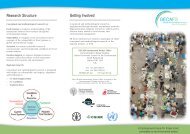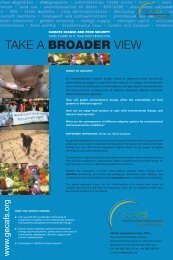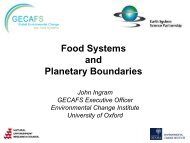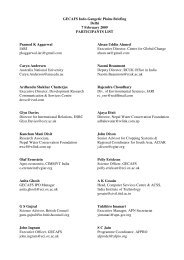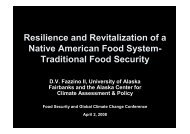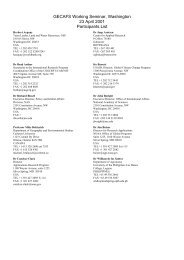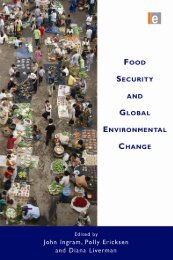Integrating the food system concept described in Papers 1-3 with this notion of scales andlevels provides a major contribution <strong>to</strong> the science agenda: it helps understanding of howfood systems actually operate by identifying the many and complex cross-scale and crosslevelinteractions they encompass. It also helps understand why actions and interventionsaimed at improving food security can fail:Building on earlier work on scales and levels (Gibson et al., 2000), Cash et al. (2006) proposethe idea of “Scale Challenges”. These are situations in which the current combination ofcross-scale and cross-level interactions threatens <strong>to</strong> undermine food security and the authorsidentify three such situations: Ignorance, Mismatch and Plurality. Paper 4 gives a generalexample where scale challenges affected famine relief in southern Africa in the early 1990s.However, integrating notions of scale with food system concepts more formally identifieswhere interventions <strong>to</strong> enhance food security can be made more effective. Take the case ofmaize trade in South East Africa. Both formal and informal trading systems operate atdifferent levels in time and space, and can be nested and/or overlapping. For the period 2000-2004, official cross-border trade in the region averaged 134 kt per year (MSU, 2008).Concurrent, informal cross-border trade was estimated at 49 kt for the five month period Apr-Aug 2009 (WFP, 2009) – about the same as the official amount, on an annual basis. Theseparallel systems gave rise <strong>to</strong> a number of scale challenges <strong>to</strong> alleviating food insecurity in theregion including (i) formal national and donor food security strategies not necessarily takingaccount for informal trade (Ignorance); (ii) trade barriers and lack of harmonisation oftrading systems and tariffs constraining food movements across borders (Mismatch); and (iii)both formal and informal trade systems being key <strong>to</strong> satisfying national food security(Plurality).The integration of these scale challenges within the food systems framework enriches thescience agenda by identifying novel ways of conceptualising how food systems operate. Italso helps food security planning by revealing where impediments arise <strong>to</strong> enhancing foodsystem activities, and hence where better formulated interventions are required. Further, italso helps highlight the range of ac<strong>to</strong>rs who need <strong>to</strong> be involved in overcoming theseimpediments. These range from formal structures in regional bodies and national and localgovernment regarding reducing tariffs, cus<strong>to</strong>ms procedures, quarantine arrangements andother barriers so as <strong>to</strong> enhance intraregional trade, <strong>to</strong> informal NGOs and civil societynetworks in providing social safety nets in times of stress.Despite the clear importance of, and value <strong>to</strong> be gained from, considering food systemactivities and their interactions across scales, and across given levels within and between eachscale, scale issues are not generally included in food “security” studies. As Wood et al.(2010) report when analysing food security issues in relation <strong>to</strong> GEC, internationalenvironmental assessments conducted <strong>to</strong> date tend <strong>to</strong> focus narrowly on the impacts ofchanges in temperature and precipitation on agricultural production. These, and otherconventional analyses, overlook key issues and linkages such as the impacts of extremeweather events on food s<strong>to</strong>rage and transport systems, increases in incidence of pests andpathogens (Gregory et al., 2009), and on food preparation (FAO, 2008a). As such, they miss110
a number of critically-important social, economic and environmental interactions with foodsecurity such as food preferences, nutritional content and food safety, let alone the manyscale issues related <strong>to</strong> these and others of the nine food security elements (Paper 3).Science contributions from taking the regional approachPaper 4 outlines the benefits of undertaking food security research at the regional level: subcontinentalregions are a natural spatial level for studies of social-ecological systems (such asfood systems) as they are often defined by shared cultural, political, economic andbiogeographical contexts – all key fac<strong>to</strong>rs in how food systems operate. While manydeterminants of food security manifest at the full range of spatial levels from local <strong>to</strong> global(e.g. trade), GEC studies have tended <strong>to</strong> focus on these two extreme levels (Introduction).Information for sub-global (continental or sub-continental) geographical regions is needed asmany food system adaptation options emerge when a regional viewpoint is adopted.Examples include improved regional strategic grain reserves, or harmonised trans-boundaryquarantine arrangements <strong>to</strong> allow rapid movement of food around the region in times ofstress.Framing food security research at the regional level yields interesting research questions,especially relating <strong>to</strong> regional policy agendas and resource management. Examples includeintra-regional food trade arrangements, or governance issues relating <strong>to</strong> regional waterresources or regional biodiversity conservation. However, while the advantages ofundertaking research at this level are presented in Paper 4, many of the food security issuesare based on socio-ecological interactions that are <strong>to</strong>o complex <strong>to</strong> study at this level alonebecause they are dependent on subregional conditions. This gives rise <strong>to</strong> three inter-relatedtypes of research questions (regional-level, subregional-level and cross-level; Paper 6). Theseall need <strong>to</strong> be addressed <strong>to</strong> cover the varied policy interests of regional stakeholders, whilerecognising the complex spatial and temporal dynamics within a region. Relating each ofthese three sets of ‘level’ questions <strong>to</strong> the notions of (i) impacts, (ii) adaptation options, and(iii) feedbacks from such options (Papers 1 and 3) gives rise <strong>to</strong> nine sets of questions (asexemplified in GECAFS, 2006a; GECAFS, 2007; GECAFS, 2008). Of the three ‘level’ typesof questions, the subregional ones are the best researched <strong>to</strong> date. Increased attention shouldnow be given <strong>to</strong> cross-level (and cross-scale) issues as understanding of the dynamic crosslevelinteractions is weak – yet these are often paramount in food security issues.Enhanced methods for stakeholder interactionAs noted above, food systems involve critical interactions at a number of levels on a range ofscales, each of which involves its own group or groups of stakeholders. Establishing effectivedialogue with these stakeholders is a crucial aspect of food security research, as elaboratedupon in Paper 5. Research planning has <strong>to</strong> recognise these multiple stakeholders and engagewith them as appropriate/possible and a range of methods including consultancies, workshopsand informal approaches can all be effective. While this stakeholder dialogue can be timeandenergy-consuming, this process in itself has three important spin-offs: (i) it helps raise111
- Page 1 and 2:
From Food Production to Food Securi
- Page 3 and 4:
From Food Production to Food Securi
- Page 5 and 6:
Table of ContentsAbstract .........
- Page 7 and 8:
Paper 6: Undertaking Research at th
- Page 9:
AbstractFood security is a conditio
- Page 12 and 13:
2010 about 925 million people had t
- Page 14 and 15:
water) are used, and reduce negativ
- Page 16 and 17:
While the flow of the argument abou
- Page 18 and 19:
determine interactions along and be
- Page 20 and 21:
Paper 3: A Food Systems Approach to
- Page 23:
From Food Production to Food Securi
- Page 26 and 27:
concerns and are now issues that mu
- Page 28 and 29:
the relationships between GEC and f
- Page 30 and 31:
Theme 2 aims to understand how comm
- Page 32 and 33:
GEC and the Food System of the Indo
- Page 34 and 35:
Paper 2: The role of agronomic rese
- Page 36 and 37:
These advances have resulted from a
- Page 38 and 39:
Crop selection to determine mechani
- Page 40 and 41:
Agronomic science is central to imp
- Page 42 and 43:
Agronomic research in relation to f
- Page 44 and 45:
The discussion above identifies a n
- Page 46 and 47:
interventions and political inertia
- Page 48 and 49:
While research on producing food ha
- Page 50 and 51:
Box 1 Food system Activities and fo
- Page 52 and 53:
In addition to broadening the debat
- Page 54 and 55:
options. Examples already seen rang
- Page 56 and 57:
Figure 3 Outcomes for 10 variables
- Page 58 and 59:
Figure 4 Nine ‘planetary boundari
- Page 60 and 61:
Figure 5 Environmental change, food
- Page 62 and 63:
Table 1: Indicative analysis of the
- Page 65:
From Food Production to Food Securi
- Page 68 and 69:
Trade Agreement (NAFTA) and the Eur
- Page 70 and 71: Parry et al., 2005). Conducting foo
- Page 72 and 73: is provided in the ESF/COST Forward
- Page 74 and 75: Paper 5: Engaging Stakeholders at t
- Page 76 and 77: into actions (strategies, policies,
- Page 78 and 79: Box 2 Engaging with stakeholders in
- Page 80 and 81: Box 3 Setting the research agenda f
- Page 82 and 83: Third, and of considerable practica
- Page 84 and 85: Figure 2: Organizing and understand
- Page 86 and 87: organizations made up of numerous n
- Page 88 and 89: Elements of good practice in stakeh
- Page 90 and 91: Finally, it is worth noting that fo
- Page 92 and 93: development (Lee, 1999; Gunderson a
- Page 94 and 95: Box 7 The GECAFS stakeholder survey
- Page 96 and 97: ‘break down’ what might be a hi
- Page 98 and 99: Paper 6: Undertaking Research at th
- Page 100 and 101: agriculture in many parts of the wo
- Page 102 and 103: gaps. The presence of a strong tech
- Page 104 and 105: an average of two years to coalesce
- Page 106 and 107: Institute for Meteorology and Hydro
- Page 108 and 109: Identifying case study sitesResearc
- Page 110 and 111: can both benefit from and contribut
- Page 112 and 113: Box 5 Mapping stakeholder interests
- Page 114 and 115: Holding planning meetings in locati
- Page 116 and 117: This reorientation of the debate fr
- Page 118 and 119: Importance of this type of research
- Page 122 and 123: awareness of the GEC issues within
- Page 124 and 125: pollutants were then introduced as
- Page 126 and 127: communities operating in food syste
- Page 128 and 129: Improving input-use efficiency acro
- Page 130 and 131: governance focuses on the range of
- Page 132 and 133: Developing research agendas in supp
- Page 134 and 135: The renewed approach to interdiscip
- Page 136 and 137: BIELAK, A., HOLMES, J., SAVGÅRD, J
- Page 138 and 139: EAKIN, H. 2010. What is Vulnerable?
- Page 140 and 141: GODFRAY, H. C. J., BEDDINGTON, J. R
- Page 142 and 143: INGRAM, J. S. I. & FERNANDES, E. C.
- Page 144 and 145: LYUTSE, S. 2010. The One Billion To
- Page 146 and 147: RAYNER, S. & MALONE, E. L. 1998. Hu
- Page 148 and 149: UNDP 2006. The 2006 Human Developme
- Page 150 and 151: activities “from plough to plate
- Page 152 and 153: contribution to the science agenda:
- Page 154 and 155: urgently needed, and - given the gr
- Page 156 and 157: GECAFS plannenmakerij stelde vast d
- Page 158 and 159: ieder hun eigen groep van betrokken
- Page 160 and 161: het gebied van beheer hebben betrek
- Page 162: Curriculum VitaeFollowing a BSc in



